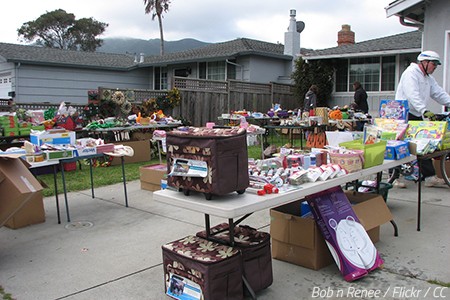 If you’ve lived under one roof for more than 5 years, then the chances are that you will be surrounded by a great number of material things that are supposed to make your life easier and more fun.
If you’ve lived under one roof for more than 5 years, then the chances are that you will be surrounded by a great number of material things that are supposed to make your life easier and more fun.
In most cases, owning stuff defines who you are and what you are passionate about – you wouldn’t own a massive book collection if you didn’t like reading books, and you wouldn’t own a guitar if you showed no interest in music whatsoever, right?
The accumulation of stuff is often inevitable – after all, what would a home look like without any pieces of furniture, furnishings, electric appliances, electronic equipment, and of course – your personal items that you prize so much?
And naturally, things are perfectly fine until the moment comes when circumstances force you to move to another home, often in another city or a different state. For when it’s time to move house, you just can’t take all your possessions with you. Or to put it better, you can but you shouldn’t.
Isn’t it easier and faster to just throw everything you own into boxes and finish the packing job in style? Not really.
Learn how to get rid of clutter before moving, and why you should do it in the first place.
Why less stuff will help you move house for less
You only need to combine two facts together in order to understand the idea behind sorting out your stuff before you move and then deciding what to get rid of before it’s time to leave your current home and what to take with you to your new address.
The two little pieces of factual wisdom that will help you save loads of money in the long run are:
- In general, moving house is an expensive business! According to the American Moving and Storage Association, the average cost of an intrastate is around $2,300, while the average price of an interstate mover is $4,300.
- The moving cost is calculated on the basis of several important factors, and one of the most influential price-forming factors is the overall weight of the shipment.
READ ALSO: What are the average moving costs?
By now it should be clear to you why everyone is frantically searching for good ways to reduce the moving cost, and, keeping in mind what you just read above, you should definitely consider doing the same.
In theory, it’s relatively simple – you simply have to take much less stuff with you when you move. In practice, however, that “simplicity” could turn out to be one of the hardest things you’ll do until you reach the protection of your new home.
But why is it exactly that you should decide to get rid of unwanted household items?
Declutter your home before moving to SAVE MONEY

Some household items were never meant to have served for that long in the first place.
When you choose a professional moving company to move your furniture and all the other things to the new home, a moving expert from the company you have selected should visit your home and make a visual inspection of the items you have for moving. The in-house survey will also include risk assessment and danger evaluation, but the main purpose of the visit is so that you can get a written estimate of the moving costs.
And this is simple: the fewer items you have decided to move, the less the overall weight of the shipment will be, and therefore, the lower the quoted price will be. On Moving day, when the weight is actually measured after all the items have been loaded onto the moving truck, you may have to pay even less if that weight is kept to its absolute minimum. And that should save you a lot of money.
Declutter before moving to MAKE MONEY
To manage to keep more money in your bank account during that transitional time is great, but what could be even greater is the prospect of earning extra cash to help your own moving budget. And your informed decision to get rid of unwanted items before you move will help you get that fresh cash flow. How?
By selling the things you no longer need, either online or at a garage sale, you’ll be able to pocket some much-needed cash and lower the transportation costs at the same time. Read on to learn more details about the benefits of a moving sale.
Get rid of clutter before moving to SAVE TIME
As one of the most powerful cost-saving techniques when moving house, selling, repurposing, donating, recycling, or throwing away all the unwanted things will let you save BIG. But that is not all – moving with fewer household items will also let you save valuable packing time as you won’t have to sort, inventory, prepare, and pack them.
Purge your stuff before moving to SAVE SPACE
The more unneeded items you choose to move to the new place, the more storage space you will need to put them away someplace safe. And that’s exactly why moving only the things you do like and intend to use in the future will let you save valuable storage space in the new home – something that is especially important when you’re moving into a smaller home (downsizing).
Purge your home before moving to REDUCE STRESS
Moving too much clutter is known to increase the levels of stress during a move simply because you know that you will have to pay more to transport all those items of yours, you know that it’ll take you more time and money to pack up those things, and you know that it’ll probably be a struggle to store those unwanted items in the new home.
A decluttered home means a decluttered mind, so make sure you follow these tips for decluttering before moving.
What to get rid of when moving
Once you realize the clear benefits of relocating with fewer belongings, the next step is to identify the things to get rid of when moving in order to decide what to do with them. This time-consuming task is called sorting /inventorying/, and it’s exactly what you are advised to do the moment you find a bit of time on your hands.
Follow the next few steps to be able to complete the sorting process quickly so that you can start work on other equally important tasks. Here’s how to get rid of clutter before you move out:
- Step 1. Initiate the sorting process one room at a time, and make sure you begin from the rooms with the most items in them.
- Step 2. Start sorting out the big items first (furniture, electric appliances, specialty household items, etc.) and then move on to the smaller ones (books, clothes, bathroom products, etc).
- Step 3. Create a quick classification method to finish the sorting job faster. As a rule of thumb, you are encouraged to have at least the following 4 major categories: must-take items, valuables, unwanted/unneeded items, and useless items.
- Step 4. Identify the must-take items. While writing down all the things you own, mark down the possessions that you will definitely take with you. These are the no-brainers: your recently purchased flat-screen TV will come with you as will the set of expensive soft furniture pieces you bought for the living room. Also, your rare collection of first-edition books will look lovely on the bookcase in your new home. Whatever indispensable items fall into this group, they need to make it safe and sound to the new address.
- Step 5. Guard your valuables. Valuable items can mean so much for you for a number of reasons – monetary value, sentimental value, and so on. These are usually the things you will not easily part with unless you come to the conclusion that it’s better to sell some of them (not the sentimental ones, of course) prior to the move to earn money and save space – read on to learn of your sale options. For the time being, however, your primary goal is to set them apart: expensive electronic equipment, jewelry pieces, heirlooms, antiques, emotional gifts, and of course – your child’s very first pair of shoes.
-

It’s sad when things that used to mean the world to somebody are later just thrown away.
Step 6. Mark all unwanted or unneeded stuff. This is the category that you need to close pay attention to because getting rid of the stuff found in it is your priority. Yes, successful sorting and consequent reduction of the number of your no longer needed items will let redirect more financial resources to other essential relocation aspects that require them. So, what are the things you may no longer want or need?
- Outdated or outgrown items such as shoes, clothes, children’s toys, and so on;
- Duplicate items – do you really need 3 toasters and 2 microwave ovens?;
- Forgotten items – when was the last time you used your tennis racket? Sports equipment, musical instruments, and other special-purpose things are just a small taste of what was once great and useful but is now forgotten and useless;
- Collector’s items you no longer care about. Maybe it’s time to cash out on a sizable collection that stopped giving you any joy a long time ago? Re-evaluate your options with the factors Money and Space in mind.
- Gifts you never really liked. No, you’re not supposed to sell or give away presents made by friends or family or relatives but that big and heavy bowling ball… you don’t even like bowling that much.
- Step 7. Useless stuff. Well, you know perfectly well what you should do with anything that is broken or damaged beyond repair, or worn out beyond any further usage. Or, if you’re still not sure, see the next section to see what options you have to get rid of unwanted items in your home.
How to get rid of stuff before moving
Once you have sorted out and categorized all of the items in your home, it will become much easier to actually do something about the stuff you will not take with you. At times, you are likely to face up some tough decisions as to whether to pay for the relocation of specific items or not. Don’t be surprised to experience difficulties with the Unwanted/Unneeded category because those will be the things you are supposed to optimize in the first place.
For now, let’s assume that you’ve made all the right decisions and your next task is to figure out how to get rid of your stuff when you move – that is, the things you’re not moving to your new residence. Luckily, you have a number of good options.
Option 1. Sell your unwanted things online
Believe it or not, selling your unwanted items online is the best way to purge stuff before moving. The truth is that you know WHY you should do it too – to earn additional money to cover your moving costs! And who could possibly say NO to that!
Here are the main points to consider when selling stuff online:
-

Selling stuff online is convenient but few things can match the thrill of a good garage sale.
Unless you’re putting up for sale hot items at low prices, selling unwanted items online takes time. Count the days you have until Moving day and try to figure out if you’ll have enough time or not. You can always attempt to sell online some items after the move but you will have already paid for their transportation, so the purpose will be defeated.
- Prepare the items you want to sell on the Internet – clean them thoroughly or do some minor repairs to make them look good.
- Assess the value of your stuff and think of reasonable prices that will sell relatively fast. If you’re not sure about the price tags, see how similar products are priced at a few reputable websites. Warning: Do not price your items too low because you don’t want to lose money at the end of the day.
- Make quality photos of the products and do create close-up photographs of problematic areas in order to sell things online successfully.
- Take your time in writing a catchy ad that will attract potential customers – include important background information about the products, make sure you mention their strengths and don’t forget to say why you are selling them as people will try to figure out if there’s a catch or not.
- Decide how your items will be shipped and what payment methods you will accept.
- Be as honest as possible as there is little to gain from trying to trick people. Respond quickly to any inquiries about the items and keep a friendly tone throughout.
- Consider using the top-rated websites for selling things: Amazon, eBay, and Craigslist.
Option 2. Sell your unneeded items at a moving sale
Organizing a moving sale prior to moving can be a great option for you to get rid of unwanted things in your home. Whether you will call it a garage sale or a yard sale, the idea here is to invite people from nearby neighborhoods to come to your home and buy something from the things you have displayed on your yard and in your garage.
The top 5 things to know when organizing a garage sale are:
- Saturdays are considered the best days to hold a garage sale before moving but weekdays can also prove to be beneficial, especially if you aim at people who drive by your house to or back from work.
- It’s best to start the sale early in the morning (8 am) so that you can catch the morning traffic of people and have the entire day for profitable deals.
- Contact the local authorities to see if you will need a special permit to hold a moving sale – some areas require that you do.
- Similar to online sales, clever advertising is key for a successful garage sale, as is reasonable pricing.
- Keep the open sale safe for small children, think of ways to make the entire area more attractive, and be open to greet all sorts of people with a friendly smile.
MUST READ: How to organize a profitable garage sale
Option 3. Give away unwanted things to friends and family

A recycling center can be the logical end for the things you no longer need or want.
Are you still searching for the best way to get rid of unwanted things? Search no more!
There’s no doubt that earning some money from the items you’re not taking with you can be useful, but nothing compares to the satisfaction of making a close friend or a family member happy by gifting them something of yours they do need or want to have.
It could be anything – from pieces of furniture through pieces of clothing to pairs of shoes – the idea here is to get a win-win situation by keeping your moving costs under control and making a friend’s day at the same time.
Option 4. Donate to charity
Of course, this option of getting rid of stuff before moving is the right one. Just think of how many less fortunate people than you could use your generosity! Your household move can be the perfect time to show that you care about your community. Besides, it’s the fastest way to get rid of things before moving house – after all, you may not have enough time to organize a moving sale or sell your things online.
Goodwill, The Salvation Army, Move for Hunger, Habitat for Humanity, and Direct Relief are just a small number of reputable charitable organizations that will gladly accept the things you don’t need anymore. Research the various charities and find out who they support. Most of them serve worthy causes but you still want to make sure your things will go to the right hands.
Also, be sure that the things you are donating are well-preserved (in good condition), clean, and still usable. Some local charity organizations will come to your home and pick up your donations while others may want you to drop them off at their locations. Research your available options before you decide how to approach it all. Remember that schools, libraries, daycare centers, nursery homes, and community centers may be willing to accept your thoughtful donation of the books you don’t intend to move to the new home. Old electronics, practical furniture, and unworn clothes are always welcome too.
Visit Charity Watch to see a complete list of charitable foundations that you can actually trust.
Option 5. Recycle the useless stuff
If none of the options above works out for you due to the bad overall condition of the things you’re leaving behind, then your final alternative is to simply throw them away for recycling. In that case, it’s important to recycle everything that can be recycled safely.
Make your household move greener by finding a recycling center near you and dispose of your unwanted or unneeded items in an environmentally friendly way.
The moving tips above just showed you the best way to get rid of clutter before moving. As a bonus, moving experts recommend that you use an excellent home decluttering rule that should help you a lot in reducing the amount of clutter right before the relocation. Whenever you are faced with a difficult decision about whether to move specific items or not, ask yourself if you’ve used those things in the last 12 months or so.
If the answer is NO, then chances are high that you just don’t need them, therefore it’ll be best to get rid of the unused things so that you don’t pay for their transportation. After all, why should you pay to move something if you haven’t used it in more than a year?
The post How to Get Rid of Stuff Before Moving appeared first on The Moving Blog.







